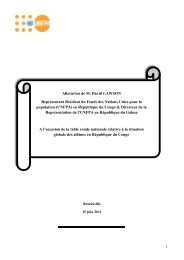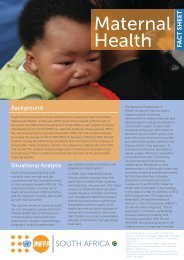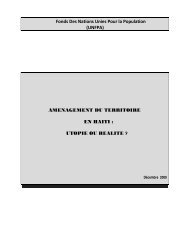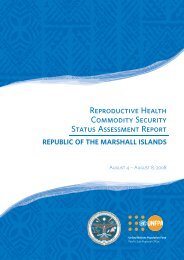A reproductive health needs assessment in Myanmar
A reproductive health needs assessment in Myanmar
A reproductive health needs assessment in Myanmar
Create successful ePaper yourself
Turn your PDF publications into a flip-book with our unique Google optimized e-Paper software.
A Reproductive Health Needs Assessment <strong>in</strong> <strong>Myanmar</strong><br />
them, and directly observed exam<strong>in</strong>ations. The survey found that exam<strong>in</strong>ations often were<br />
not adequate, especially for women. It also confirmed that providers tend not to utilise a<br />
standardized, syndromic approach and generally treated just one disease, usually either<br />
gonorrhoea or syphilis. The <strong>health</strong> facility survey recommended that <strong>in</strong>terventions focus on<br />
identify<strong>in</strong>g those providers who serve the largest numbers of STD clients, and work to<br />
encourage and strengthen a syndromic approach to treatment. In addition, improvements <strong>in</strong><br />
exam<strong>in</strong>ations, condom counsell<strong>in</strong>g, and partner notification were cited as priority areas. At<br />
the moment, private GPs generally do not stock condoms because they are concerned that this<br />
will ru<strong>in</strong> their reputation as a service provider (because condoms are so closely associated<br />
with prostitution). One STD team we visited reported that they do not rout<strong>in</strong>ely give<br />
condoms to STD patients “because they won’t use them.”<br />
Prevention and partner notification<br />
RTI and STD case management is primarily focussed on treatment of <strong>in</strong>dividuals. GPs<br />
mentioned that, despite their advice to use condoms for prevention of future <strong>in</strong>fection, most<br />
<strong>in</strong>dividuals do not use them. There is apparently very little active counsell<strong>in</strong>g for condom use<br />
and condoms are rarely actually given to clients.<br />
Notification, referral and treatment of partners are also rare <strong>in</strong> cases of documented STDs.<br />
There is some attempt at such outreach <strong>in</strong> those Townships where there is an active STD<br />
team (only 25 townships out of 320), however; even their efforts appear to be quite m<strong>in</strong>imal.<br />
Most private GPs do not rout<strong>in</strong>ely advise clients concern<strong>in</strong>g the need for partner treatment.<br />
They assume <strong>in</strong> advance that such advice will not be heeded, as husbands “would not want<br />
their wives to know that they had been to sex workers.” Similarly, midwives rarely reported<br />
talk<strong>in</strong>g with women about the possibility of sexually transmitted <strong>in</strong>fection.<br />
The MCWA has also begun to distribute condoms <strong>in</strong> some of its township-level projects.<br />
This is a potentially important channel for further condom distribution; however, the volume<br />
of condoms distributed by the MCWA has been quite limited <strong>in</strong> most locales. For example,<br />
<strong>in</strong> one township where such efforts had been established, only a few hundred condoms had<br />
been dispensed <strong>in</strong> the first year.<br />
CRITICAL ISSUES CONCERNING RTIS, INCLUDING STDS, AND HIV/AIDS<br />
The above observations suggest that several issues need to be addressed to strengthen RTI<br />
prevention and treatment efforts.<br />
Although HIV/AIDS awareness is generally high, there is a lack of appreciation that<br />
prevention and treatment of other STDs can significantly slow the spread of HIV. Many<br />
providers have not yet received any tra<strong>in</strong><strong>in</strong>g (and those tra<strong>in</strong>ed are often transferred). Those<br />
who have received such tra<strong>in</strong><strong>in</strong>g often do not apply it <strong>in</strong> their community <strong>health</strong> education<br />
activities. For example, midwives perceive RTIs to be primarily a concern of men.<br />
Similarly, the public <strong>health</strong> supervisors have not been very <strong>in</strong>volved <strong>in</strong> STD prevention and<br />
control and do not see it as an important part of their duties. Responsibility for STDs is<br />
generally left to the STD Teams, which have a limited geographic coverage (only 36 teams<br />
nationwide). Even at the programme management level (central and state/divisional level),<br />
the activities for prevention and treatment of STDs and HIV/AIDS are not well <strong>in</strong>tegrated.<br />
Clearly such a l<strong>in</strong>kage <strong>needs</strong> to be established both <strong>in</strong> tra<strong>in</strong><strong>in</strong>g, IEC and service delivery<br />
activities. Develop<strong>in</strong>g a set of national guidel<strong>in</strong>es to standardize RTI case management and<br />
49

















